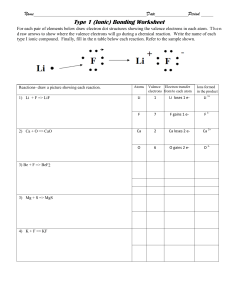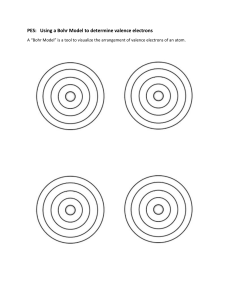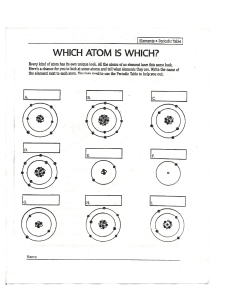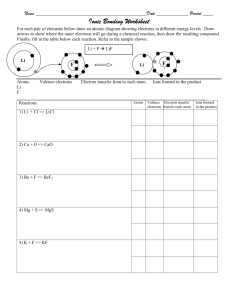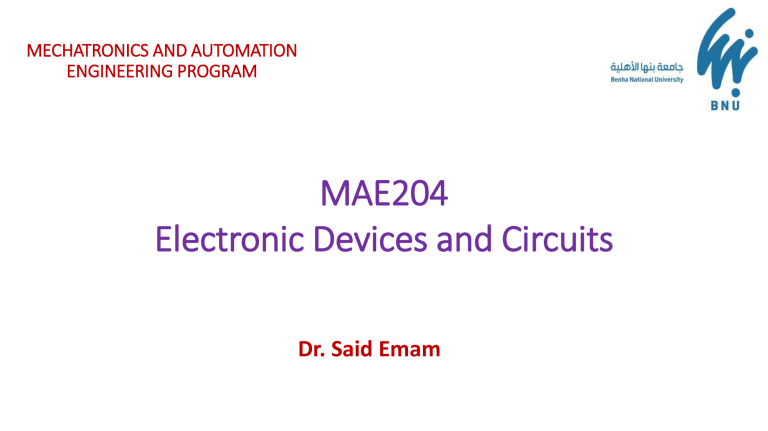
MECHATRONICS AND AUTOMATION ENGINEERING PROGRAM MAE204 Electronic Devices and Circuits Dr. Said Emam Tuesday : 9:00 – 10:40 ( E3.LH2 ) Course content References: 1. Sedra, A., Smith, K.C., Carusone, T.C. and Gaudet, V., “Microelectronic circuits”, 8th edition. (2020). 2. BOYLESTAD, Robert L.; NASHELSKY, Louis. “Electronic devices and circuit theory”. Pearson, 11th Edition, 2013. 3. FLOYD, Thomas L. “Electronic devices: conventional current version”. Pearson, 9th Edition, 2012. 4. Bates, David, and Albert Malvino. Electronic principles. McGraw-Hill Higher Education, 2021. Lecture 1 Introduction to Semiconductors • The Atom • Materials Used in Electronics • Current in Semiconductors • N-Type and P-Type Semiconductors • The PN Junction DIODE OPERATION • Voltage-Current (V-I) Characteristics of a Diode • Diode Models • Diode Applications The Atom -- The Bohr Model FIGURE 1 The Bohr model of an atom showing electrons in orbits around the nucleus, which consists of protons and neutrons. The “tails” on the electrons indicate motion. • All matter is composed of atoms; • An atom is the smallest particle of an element that retains the characteristics of that element. • Atoms have a planetary type of structure that consists of a central nucleus surrounded by orbiting electrons. • The nucleus consists of positively charged particles called protons and uncharged particles called neutrons. • Electrons have a negative charge. • Each element in the periodic table has a unique atomic structure, and all atoms within a given element have the same number of protons. • The atomic number equals the number of protons in the nucleus. • In their normal (or neutral) state, all atoms of a given element have the same number of electrons as protons; the positive charges cancel the negative charges, and the atom has a net charge of zero. Electrons and Shells • Electrons orbit only at discrete distances from the nucleus • Each discrete distance (orbit) corresponds to a certain energy level. • Orbits are grouped into energy levels known as shells. • A given atom has a fixed number of shells. • Each shell has a fixed maximum number of electrons, given by 𝑁𝑒 = 2𝑛2 where n is the number of the shell. FIGURE 2 Illustration of the Bohr model of the silicon atom. Valence Electrons • The outermost shell is known as the valence shell and electrons in this shell are called valence electrons. • These valence electrons contribute to • chemical reactions and • bonding within the structure of a material and • determine its electrical properties. • When a valence electron gains sufficient energy from an external source, it can break free from its atom. And becomes a free electron. • The external sources such as • light energy in the form of photons and • thermal energy (heat) from the surrounding medium. Ionization • If a valence electron acquires a sufficient amount of energy, called ionization energy, it escapes from the outer shell and become a free electron. • The departure of a valence electron converts a previously neutral atom to a positive ion (more protons than electrons = excess of positive charge). • When a free electron collides with the atom and is captured, releasing energy. The atom that has acquired the extra electron is called a negative ion. (more electrons than protons = excess of negative charge). MATERIALS USED IN ELECTRONICS • Insulators • An insulator is a material that does not conduct electrical current. • Most good insulators are compounds rather than single-element materials and have very high resistivities. • Valence electrons are tightly bound to the atoms ➔ very few free electrons • Ex. rubber, plastics, glass, mica, and quartz. • Conductors • A conductor is a material that easily conducts electrical current. • Most metals such as copper (Cu), silver (Ag), gold (Au), and aluminum (Al), are good conductors. • which are characterized by atoms with only one valence electron very loosely bound to the atom. These loosely bound valence electrons become free electrons. MATERIALS USED IN ELECTRONICS • Semiconductors • A semiconductor is a material that is between conductors and insulators in its ability to conduct electrical current. • A semiconductor in its pure (intrinsic) state is neither a good conductor nor a good insulator. • Single-element semiconductors like silicon (Si), and germanium (Ge). Compound semiconductors such as gallium arsenide (GaAs). • The single-element semiconductors are characterized by atoms with four valence electrons. • Silicon is the most commonly used semiconductor. Band Gap (Energy gap) • The Band gap (energy gap ) is the difference in energy between the valence band and the conduction band. • This is also the amount of energy that a valence electron must have in order to jump from the valence band to the conduction band. • Once in the conduction band, the electron is free to move throughout the material and is not tied to any given atom. • The conduction band is the band where the free electrons exist. Silicon and Germanium • The valence electrons in germanium are in the fourth shell while those in silicon are in the third shell, closer to the nucleus. • This means that the germanium valence electrons are at higher energy levels than those in silicon and, therefore, require a smaller amount of additional energy to escape from the atom. • This property makes germanium more unstable at high temperatures and results in excessive reverse current. • This is why silicon is a more widely used semiconductive material. Covalent Bonds • Each silicon atom shares its 4 valence electrons with 4 adjacent silicon atoms to form a silicon crystal. • This effectively creates eight shared valence electrons for each atom and produces a state of chemical stability. • This sharing of valence electrons produces the covalent bonds that hold the atoms together; each valence electron is attracted equally by the two adjacent atoms which share it. • An intrinsic crystal is one that has no impurities. (intrinsic ≡ pure) Covalent bonds in a silicon crystal. CURRENT IN SEMICONDUCTORS • Energy band diagram for an unexcited atom in a pure (intrinsic) silicon crystal. • There are no electrons in the conduction band. This condition occurs only at a temperature of absolute 0 Kelvin. Conduction Electrons and Holes • An intrinsic Si crystal at room temperature has sufficient thermal energy for some valence electrons to break their covalent bonds and jump the gap from the valence band into the conduction band, becoming free electrons (conduction electrons). • When an electron jumps to the conduction band, a vacancy is left in the valence band within the crystal. This vacancy is called a hole. Creating what is called an electron-hole pair. • In an intrinsic semiconductor: No. of holes = No. of free electrons (a) Energy diagram (b) Bonding diagram Conduction Electrons and Holes • Recombination occurs when a conduction-band electron loses energy and falls back into a hole in the valence band. Electron current and Hole Current • When a voltage is applied across a piece of intrinsic silicon, the thermally generated free electrons in the conduction band are easily attracted toward the positive end. • This movement of free electrons is one type of current in a semiconductive material and is called electron current. Electron current in intrinsic silicon is produced by the movement of thermally generated free electrons in the conduction band. Hole Current (Another type of current occurs in the valence band) • A valence electron can move into a nearby hole with little change in its energy level, • Thus leaving another hole where it came from. • i.e. the hole has moved from one place to another in the crystal structure, • Although current in the valence band is produced by valence electrons, it is called hole current to distinguish it from electron current in the conduction band. When a valence electron moves left to right to fill a hole while leaving another hole behind, the hole has effectively moved from right to left. Gray arrows indicate effective movement of a hole. N-TYPE AND P-TYPE SEMICONDUCTORS • Doping: is the process of adding impurities to the intrinsic semiconductive material -- in a controlled manner -- to increase its conductivity. • A semiconductor material that has been subjected to the doping process is called an extrinsic material. • There are two types of extrinsic materials : n-type and p-type. n-type p-type. N-Type Semiconductor • To increase the number of conduction-band electrons in intrinsic silicon, pentavalent impurity atoms are added. • “Pentavalent” are atoms with five valence electrons, such as arsenic (As), phosphorus (P), bismuth (Bi), and antimony (Sb). • Each pentavalent atom forms covalent bonds with four adjacent silicon atoms. leaving one extra electron which becomes a conduction electron because it is not involved in bonding. • Because the pentavalent atom gives up an electron, it is often called a donor atom. • Since most of the current carriers are electrons, The electrons are called the majority carriers in n-type material. • Holes in an n-type material are called minority carriers. (a few holes that are created when electron-hole pairs are thermally generated) P-Type Semiconductor • To increase the number of holes in intrinsic silicon, trivalent impurity atoms are added. • “Trivalent” are atoms with three valence electrons such as boron (B), indium (In), and gallium (Ga). • All three of the trivalent atom’s valence electrons are used in the covalent bonds; and, since four electrons are required, a hole results when each trivalent atom is added. • Because the trivalent atom can take an electron, it is often referred to as an acceptor atom. • The holes are the majority carriers in p-type material. • Conduction-band electrons (that are created when electron-hole pairs are thermally generated) in p-type material are the minority carriers. THE PN JUNCTION • If a piece of intrinsic silicon is doped so that part is n-type and the other part is p-type, a 𝑝𝑛 junction forms at the boundary between the two regions and a diode is created. (a) Free electrons in the n region near the pn junction begin to diffuse across the junction and fall into holes near the junction in the p region. (b) For every electron that diffuses across the junction and combines with a hole, a positive charge (positive pentavalent ion) is left in the n region and a negative charge (negative trivalent ion) is created in the p region, forming a barrier potential. This action continues until the voltage of the barrier repels further diffusion. Formation of the Depletion Region • The free electrons in the n region are randomly drifting in all directions. • At the instant of the pn junction formation, the free electrons near the junction in the n region begin to diffuse across the junction into the p region where they combine with holes near the junction. • This action creates a positive charge (positive pentavalent ion) in the n region and a negative charge (negative trivalent ion) in the p region, which form the depletion region (depleted of charge carriers [electrons and holes] due to diffusion across the junction). • This action continues until a point is reached where the total negative charge in the depletion region repels any further diffusion of electrons into the p region and the diffusion stops. • In other words, the depletion region acts as a barrier to the further movement of electrons across the junction. • The depletion region is formed very quickly and is very thin compared to the n region and p region. Barrier Potential • The positive and negative ions in the depletion region form an electric field, • This electric field is a barrier to the free electrons in the n region, and energy must be expended to move an electron through the electric field. • The potential difference of the electric field across the depletion region is the amount of voltage required to move electrons through the electric field. • This potential difference is called the barrier potential and is expressed in volts. • The barrier potential of a pn junction depends on several factors, including the type of semiconductive material, the amount of doping, and the temperature. • The typical barrier potential is approximately 1.2V for GaAs, 0.7 V for silicon and 0.3 V for germanium at 25°C. In Summary- Selected Key Terms • Atom The smallest particle of an element that possesses the unique characteristics of that element. • Proton The basic particle of positive charge. • Electron The basic particle of negative electrical charge. • Shell An energy band in which electrons orbit the nucleus of an atom. • Valence Related to the outer shell of an atom. • Ionization The removal or addition of an electron from or to a neutral atom so that the resulting atom (called an ion) has a net positive or negative charge. • Insulator A material that does not normally conduct current. • Conductor A material that easily conducts electrical current. • Semiconductor A material that lies between conductors and insulators in its conductive properties. Silicon, germanium, and carbon are examples. In Summary- Selected Key Terms • Crystal A solid material in which the atoms are arranged in a symmetrical pattern. • Free electron An electron that has acquired enough energy to break away from the valence band of the parent atom; also called a conduction electron. • Hole The absence of an electron in the valence band of an atom. • Doping The process of imparting impurities to an intrinsic semiconductive material in order to control its conduction characteristics. • PN junction The boundary between two different types of semiconductive materials. • Barrier potential The amount of energy required to produce full conduction across the pn junction in forward bias.

